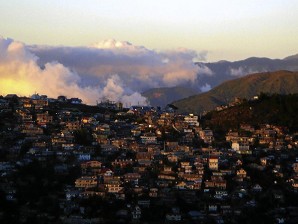
VULNERABLE CITY. A view of Baguio City, considered the most vulnerable to climate change among four cities outside the National Capital Region due to its vulnerable to extreme weather events, according to the World Wide Fund for Nature-Philippines, which did the study. INQUIRER FILE PHOTO
MANILA, Philippines—Baguio City, densely populated and right on the typhoon belt, is most exposed and vulnerable to extreme weather events compared to other major regional cities in the Philippines, according to the World Wide Fund for Nature-Philippines (WWF).
A Climate Risk Assessment Study made by the WWF-Philippines and the Bank of the Philippine Islands Foundation Inc. of the cities of Baguio, Cebu, Iloilo, and Davao showed that the northern Luzon metropolis has become most vulnerable to climate change.
WWF-Philippines chief executive officer Jose Ma. Lorenzo Tan said the study should give city planners and government agencies insights on how to plan their cities with these challenges ahead.
“Each city faces its own set of advantages and disadvantages in adapting to a sustainable future. Now that we have the insights, from the potential of Cebu to grow by establishing its own airport to the threat of rising sea levels to Iloilo’s reclaimed lands, WWF and BPI Foundation invite institutions within these cities and the government in particular to initiate more eco-friendly solutions for the development of our country,” shares WWF-Philippines Vice-Chair and CEO Jose Ma. Lorenzo Tan.
The WWF released its findings as world leaders conduct another round of talks under the United Nations Framework Convention on Climate Change in Durban, South Africa.
The UN FCCC eyes to cut greenhouse gas emissions by 50 per cent by 2050 and stop the planet from heating up by 2 degrees C, which would cause extreme weather events.
According to the study, Baguio City, the country’s summer capital, is the most exposed to climate change effects, with rains seen as its number one enemy. Intense storms would result to flooding and landslides, which could cut off Baguio City from economic activities.
It would also be harder for the metropolis to respond to the changes due to rapid urbanization and high population density, the WWF said.
“At barely 57 square kilometers, Baguio City is the smallest, and most densely populated, city covered by this study. In the scoring process, it also emerged as the most vulnerable to climate change impacts,” the report said.
“All historical records confirm that Baguio City has the highest rainfall in the country, and climate trends indicate that this is likely to get worse. From a climate point of view, the management of urbanization trends and watersheds as well as Baguio’s population growth, will play major roles in defining the continued viability of this city’s economy,” the report added.
Of the four cities surveyed, Baguio City is the only one on the direct path of typhoons, which usually hit Central and Northern Luzon, making it prone to landslides.
According to the government’s 2008 census, Baguio City has 300,000 residents and is growing at 2.5% every year. The city has 5,250.9 persons per square kilometers, which puts pressure on its scarce resources.
Davao was seen as the least vulnerable among the cities with room for sustainable, integrated area development, the WWF said. Davao City has a population of 1.3 million, but it has a population density of 558 persons per square kilometer. It is also not in the path of storms. However, the coastal city would have to grapple with sea level rise, ocean acidificiation, and high growth rate, WWF said.
“Davao City still has significant land area to build new, more livable satellite developments. In this assessment, it emerged as the least vulnerable city, overall. Its opportunity is to do things the right way,” the report noted.
Although Iloilo is rapidly becoming urban and is flood-prone, it has managed to keep its population growth down to 1.53%, much lower than the national average. The low population growth of this Central Visayas port city has eased the pressure on its natural resources.
“Iloilo City has the second highest population density of the four cities in this study. Sitting on reclaimed marshland, it also remains highly flood-prone. In combination, these two factors constitute a serious risk. Next to Baguio, Iloilo City emerged as the second most vulnerable city in this study,” the report said.
Cebu City has also been facing extreme wet and dry weather events, the report said. Salt water intrusion, sea level rise, and storm surges due to stronger storms are the challenges it would face in the future.
However, Cebu has a strong adaptive capacity. According to the report, the Queen City of the South has an opportunity and resources to reinvent itself with investments to ‘climate-proof’ infrastructure and technology to strengthen its current economic supply chains.
The WWF research analyzed the level of vulnerability of each city by studying their climate/environmental exposure, socio-economic sensitivity and capacity to adapt and respond to the challenges using historical data from 1990 to 2010.
The first factor juxtaposed local climate scenarios and city-specific weather information while socio-economic sensitivity examined variables such as population, agriculture, tourism, new and existing businesses and investment, health and educational enrollment.
The study also assessed variables such as labor/ work force, city revenue/ expenditures/ reserves, functional literacy, which indicates the population’s ability to adapt to changes.